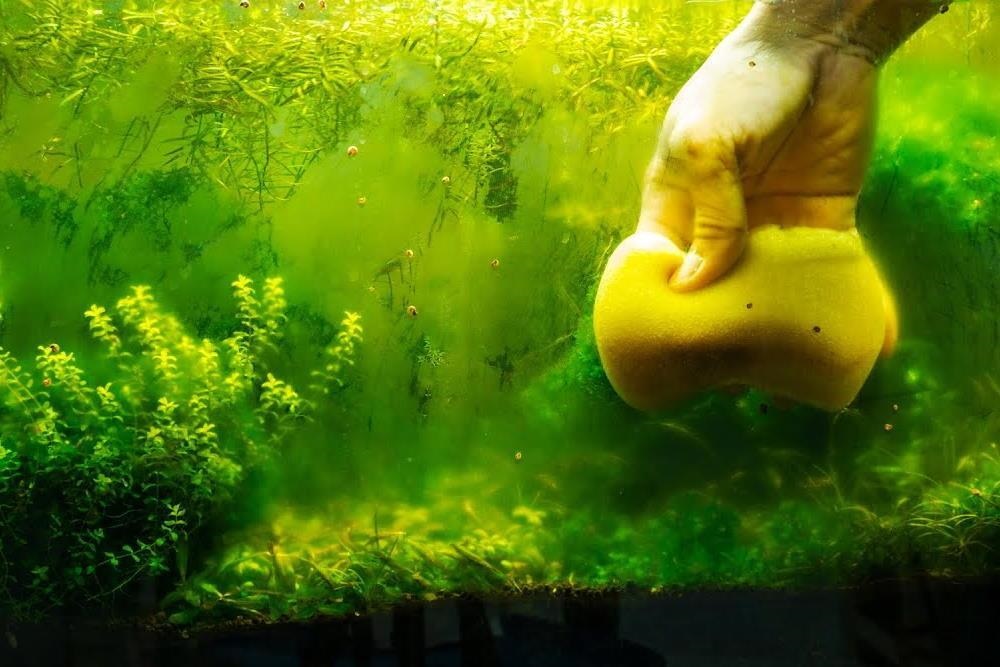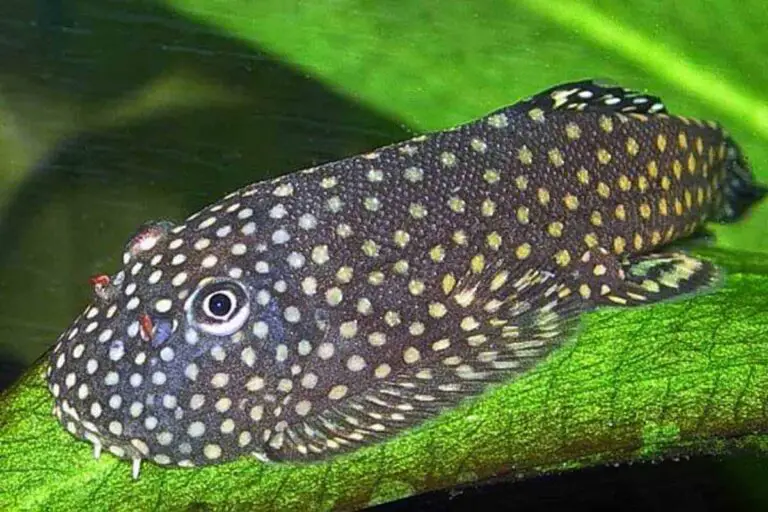How to Get Rid of Mold in Fish Tank?
Mold in a fish tank is caused by improper cleaning and maintenance, leading to poor water quality.
To get rid of mold, you’ll need to clean the aquarium thoroughly. Start by emptying out all the water and removing any decorations or gravel.
Next, scrub down the walls of the tank with hot soapy water and use a soft-bristle brush to remove any dirt or debris that has stuck on it.
After this step is complete, rinse off all surfaces and fill your tank back up with fresh dechlorinated water that matches your fish’s habitat conditions (temperature, pH levels).
Finally, make sure you’re performing regular maintenance such as replacing 25% of the aquarium’s water every two weeks to keep mold from coming back again.
Clean the tank: Start by removing all decorations, plants, and gravel from the fish tank.
Use a scrub brush to remove any visible mold growth on the walls of the aquarium.
Then rinse off these items in hot water to disinfect them before returning them back into your tank.
Replace Water: Drain out all of the water inside your fish tank and replace it with fresh, clean tap water that has been conditioned to make it safe for your aquatic pets.
Discard any remaining contaminated substrate or materials used in the aquarium as they can still harbor traces of mold spores even after being washed off.
Clean Filter Components: After replacing all of the water in your fish tank, take apart each filter component.
And thoroughly clean them using hot running tap water until there are no more signs of dirt or grime left.
Before reassembling everything back together again for use in your aquarium setup once more.
Bleach Treatment: When dealing with severe cases of mold in a freshwater or saltwater aquarium, it might be necessary to resort to a bleach treatment.
This can effectively remove the mold from the tank’s walls and other surfaces that are directly exposed to air.
Even decorative elements like rocks or driftwood pieces can become a breeding ground for mold, especially if they’re near light sources that create high humidity levels.
This humidity can foster fungal overgrowth if not managed properly.
Therefore, it’s crucial to address this issue promptly.
One way to prevent mold growth is through regular maintenance practices, such as conducting weekly 25% partial water changes.
These should be carried out at scheduled intervals throughout the year.
However, it’s important to note that the specific requirements and needs for mold prevention can vary.
They should be determined on an individual basis, taking into account the unique circumstances of each case.

Credit: fishlab.com
Why is There Mold Growing in My Fish Tank?
Mold growth in fish tanks is a common problem, and there are several possible causes.
One of the most common reasons for mold growth is high levels of moisture.
If the environment inside your tank is too humid, it can create an ideal atmosphere for mold to form.
Another factor that can lead to mold growth in your tank is poor filtration or ventilation.
Poor filtration can allow debris, bacteria, and other pollutants to accumulate on surfaces.
Within the tank where they may be able to foster mold growth if conditions remain moist enough for long enough periods of time.
A third potential cause could be overfeeding; excess food left uneaten will break down into ammonia-rich waste.
Which provides nutrient sources for some types of molds while also raising water pH levels which increases their survivability rate.
Finally, you should check whether any recently added decorations or plants may contain spores.
That encourage fungal reproduction as this could explain why certain areas of your aquarium have been affected more than others.
Can Mold in Fish Tank Kill Fish?
Mold, a type of fungus that thrives in dark and damp places, can be deadly to fish if it grows in their tank.
It can quickly colonize organic material such as uneaten food, dead plants, or even the tank walls.
When mold is present in large amounts, it becomes a hazard to both humans and fish.
This is due to the mycotoxins it produces, which are harmful to humans when inhaled or absorbed through skin contact, and toxic to fish when ingested.
The situation can worsen as mold spores can contaminate air filters, causing respiratory issues for fish as they try to extract oxygen from water polluted by decaying matter.
In severe cases, fish may die from suffocation or impaired breathing if their gills become clogged with mold spores, leading to a decrease in oxygen levels within the tank.
It’s a complex issue that requires a tailored approach for prevention and treatment.
What is the Black Mold Looking Stuff in My Fish Tank?
If you’ve noticed a black mold-like material growing in your fish tank, it could be a type of algae known as Black Beard Algae (BBA).
This variety of algae is common in aquariums and can form long stringy patches or mats that appear to move.
It can also look like hair, hence its name.
BBA thrives in warm water conditions with high levels of carbon dioxide and low levels of light.
While it isn’t toxic to your fish, if left untreated it can spread across the glass walls and decorations within the tank making them unsightly and difficult to clean.
The best way to treat Black Beard Algae is by manually removing any visible growths using tweezers or a toothbrush.
Once they are removed, reduce the light exposure in the tank as well as increasing oxygenation through more frequent water changes which will help keep BBA at bay.
Regular maintenance such as cleaning filters, vacuuming gravel beds and pruning live plants should also help prevent further outbreaks from occurring in the future.
What Kills Water Molds?
Water molds are a type of fungi that live in watery environments and feed on organic material.
They can be found in freshwater, saltwater, and even soil habitats.
While they may not seem like much of a threat to humans or other animals, they can cause considerable damage to crops and aquatic life.
The most effective way to kill water molds is through chemical treatments such as chlorine or bromine compounds, which will prevent the growth and spread of these organisms.
Physical removal of the infected area is one method. Ultraviolet radiation treatment can also be used.
Copper sulfate treatments are effective for controlling algae. Ozone treatments can control bacteria.
Biological controls are another option. This involves introducing predators into the environment that prey specifically on the water mold species.
Chemical treatments can be effective in initially eradicating water molds. However, it’s crucial to maintain regular upkeep procedures.
This is to prevent these molds from getting a chance to re-establish themselves in the ecosystem.
White Fuzzy Mold in Fish Tank
White fuzzy mold is a common problem in aquariums and can be caused by high levels of organic matter, such as fish waste or uneaten food.
It typically appears as white fuzz on the surfaces of the tank, rocks, or decorations. If left untreated, it can quickly spread and become a health hazard for your fish.
There are several methods to help prevent and remove white fuzzy mold from your aquarium including regular water changes and proper filtration systems.
How to Stop Mold in Fish Tank?
To prevent mold growth in your fish tank, make sure you are regularly cleaning and replacing the aquarium filter media.
Ensure that excess food is removed from the tank on a daily basis to reduce decomposition and prevent nutrient-rich conditions that can encourage mold growth.
You should also keep an eye out for any white patches or spots on plants – these may be signs of early mold development.
Finally, maintain optimal water quality by testing it weekly and adjusting as necessary with dechlorinated water treatments.
How to Get Rid of Black Mold in Fish Tank?
Removing black mold from fish tanks is an important step in keeping your tank clean and healthy.
To do this, start by removing the fish and any other inhabitants of the tank.
Next, use a sponge to scrub away as much of the mold as possible.
Make sure to wear gloves while you are doing this! Afterwards, rinse out the tank with hot water and use a diluted bleach solution (1 part bleach to 10 parts water) to disinfect it thoroughly.
Finally, replace all rocks and decorations before adding back in your fish or other occupants – making sure that everything has been properly cleaned first.
Is Fish Tank Mold Dangerous to Humans?
Fish tank mold is not harmful to humans, as it does not produce any toxins.
However, if you have a fish tank with mold in it, it can create poor water quality which may be detrimental to your fish or other aquatic life.
It’s important to clean the inside of your fish tank regularly and check for signs of mold growth so you can prevent it from spreading and harming your pet’s environment.
How to Get Rid of White Fungus in Fish Tank?
White fungus in fish tanks can be a challenge to get rid of, but it is possible.
Start by reducing the amount of light and increasing water flow in the tank, as this will help inhibit its growth.
Next, test your tank’s water parameters to make sure they are within acceptable levels.
Finally, add an aquarium-safe antifungal medication or chemical treatment specifically designed for white fungus removal to kill any remaining fungus spores in the tank.
Why is There Mold in My Fish Tank?
Mold in a fish tank is usually caused by excessive moisture, including too much humidity, inadequate ventilation and an excess of organic matter.
These conditions create the perfect environment for mold to grow.
To prevent this from happening, you should make sure that your fish tank is properly ventilated and cleaned regularly to remove any decaying food or plant material that could be providing a source of nutrition for mold spores.
Brown Mold in Fish Tank
Brown mold often appears in fish tanks as a result of organic matter, such as leftover food or decaying plants, breaking down and releasing nitrate into the water.
In addition to releasing an unpleasant smell, these molds can be dangerous for fish tank inhabitants if left untreated.
It is important to take proactive measures to reduce the presence of brown mold in your aquarium by regularly cleaning out debris and removing any dead plant material from the tank.
Regular water changes also help keep brown mold at bay by reducing levels of nitrates.
White Mold on Fish Tank Lid
White mold on the lid of a fish tank is usually caused by high levels of moisture and humidity in the air.
Over time, this can create an ideal environment for mold and mildew to grow.
To prevent white mold from growing on your tank lid, be sure to clean it regularly with a soft cloth or sponge dampened with warm water and vinegar or bleach solution.
You should ensure that your aquarium has adequate ventilation and temperature control to keep the air around it dry.
Conclusion
Mold in your fish tank is an unpleasant and potentially dangerous problem, but thankfully it’s not one that you have to live with.
With a few simple steps, you can get rid of mold in your fish tank safely and quickly.
Start by removing any decorations or plants from the tank, then do a thorough cleaning with vinegar or bleach before adding fresh water.
Finally, make sure to keep up on regular maintenance such as changing the water every two weeks and performing weekly partial water changes.
By following these steps, you’ll be able to fight off mold growth and provide a safe environment for your beloved fish.




